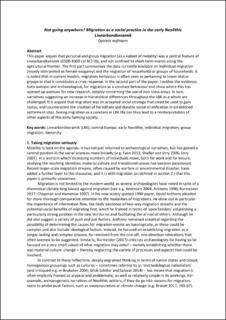Not going anywhere? Migration as a social practice in the early Neolithic Linearbandkeramik
Journal article, Peer reviewed
Accepted version
Permanent lenke
https://hdl.handle.net/11250/2755805Utgivelsesdato
2020Metadata
Vis full innførselSamlinger
Originalversjon
Quaternary International. 2020, 560–561, 228-239 https://doi.org/10.1016/j.quaint.2020.04.002Sammendrag
This paper argues that personal and group migration (as a subset of mobility) was a central feature of Linearbandkeramik (c. 5500-4900 cal BC) life, and not confined to short-term events along the agricultural frontier. The first part summarises the data currently available on individual migration (mostly interpreted as female exogamy) and the migration of households or groups of households. It is noted that in current models, migratory behaviour is often seen as pertaining to lower-status groups or that it constitutes a crisis response. In the second part of the paper, I outline the evidence, both isotopic and archaeological, for migration as a constant behaviour and show where this has opened up avenues for new research, notably concerning the use of non-loess areas. In turn, narratives suggesting an increase in hierarchical differences throughout the LBK as a whole are challenged. It is argued that migration was an accepted social strategy that could be used to gain status, and counteracted the creation of hereditary and durable social stratification in established settlement sites. Seeing migration as a constant in LBK life can thus lead to a reinterpretation of other aspects of this early farming society.

